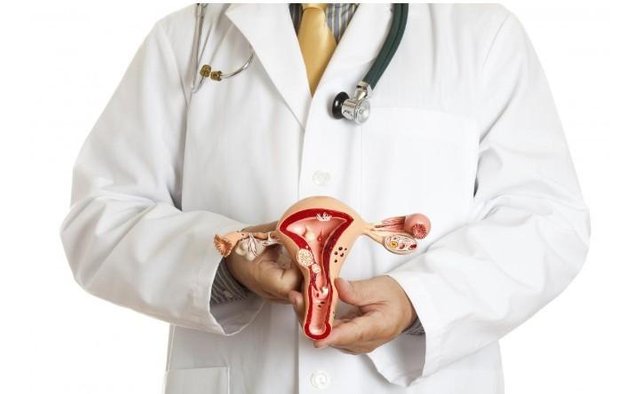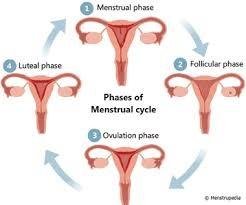It's been a while since I made a post related to health but it shouldn't matter anyway because I don't think am rusty in health pertaining matters just yet. Today, I'll be putting Corpus Luteum into consideration.
What is Corpus Luteum?
 A Corpus Luteum forms in the ovary
A Corpus Luteum forms in the ovaryCorpus Luteum in a very simple language, is a number of cells that form in the ovary during the early pregnancy. The Corpus Luteum is in charge of the production of progesterone but in very technical or scientific way, the corpus luteum is an endocrine structure, and don't forget it only forms during pregnancy so it's a temporary endocrine structure that produces progesterone in relatively high levels, estradiol and inhibin A in moderate levels and estrogen in small levels.
As we all know, the body of the woman usually prepares for pregnancy during their reproductive years through the menstrual cycle. The cycle has four phases, the menstruation, the Follicular, the ovulation - not really our concern, and the luteal phase which lasts for about 2 weeks. It is during this luteal phase that the corpus luteum forms in the ovary but before it begins to form? A matured egg must have popped out of the follicle because until a follicle houses a maturing egg and pops it when it matures, there can be a formation of the corpus luteum. This is because corpus luteum is formed by the follicle and only follicles that have housed a matured egg can form it.
The corpus luteum is essential for conception to occur and for pregnancy to last.
OK, let me take some time to explain the four phases of the menstrual cycle.
The Menstrual cycle

The Four Phases of the Menstrual Cycle
What did you really know about the menstrual cycle? Well, let me say it is an evidence of reproductivity for the female, it is a monthly natural change occurring in the reproductive system of the females, it makes pregnancy possible for them, the cycle prepares the uterus for pregnancy, what else?
The menstrual cycle has four phases which I want to discuss in a little while. The four phases are in the picture above but let me write it in case it's not clear enough.
- The Menstrual Phase
- The Follicular Phase
- The Ovulation Phase
- The Luteal Phase
Number One. . .
The Menstrual Phase
This is better known as menstruation. Most of us really think menstruation is just the release of blood through the vagina but really, it isn't - blood is just a component. Menstruation is the removal of the endometrium through the vagina. The endometrium is the thickened lining of the uterus. The components of the menstrual fluid are:
- Blood
- Cells from the endometrium
- Mucus
Menstruation under normal circumstances should not be less than 3 days just as it shouldn't be more than 7 days. It is important to practice good hygiene during menstruation. Most ladies prefer the sanitary pads to the tampons but whichever one you use, you should change it after 5 hours.
P. S. Tampons have recently been linked to the toxic shock syndrome.
Number Two. . .
The Follicular Phase
The Follicular Phase starts on the same day as menstruation and ends just before ovulation. A section of the brain, the hypothalamus is responsible for making the pituitary gland release "follicle stimulating hormones(FSH)". As a stimulating hormone, it works on the ovary to produce about 5 to 20 follicles.
Just like I said earlier, the follicles house an immature egg – each follicle houses one immature egg. Out of the 20 follicles produced, only one matures, the others die and this is usually 3 days after the end of a 7-day menstruation or let's just say it happens on the 10th day of a 28-day menstrual cycle but the follicular phase is from Day 1 – 13.
Number Three. . .
The Ovulation Phase
After the maturation of the egg, the next thing is its release from the dominant follicle although the release is stimulated by the luteinizing hormones. The phase begins on the 14th day of the menstrual cycle and lasts for about 16 – 32 hours. Because the ovulation occurs on the 14th day–the perfect half of a 28–day cycle, I can say ovulation happens 2 weeks before or after menstruation.
The hypothalamus, apart from being responsible for making the pituitary gland release "follicle stimulating hormones", another thing the hypothalamus does is that it notices the rise in the level of estrogen caused by the development of follicles. So, the hypothalamus releases gonadotrophin releasing hormone (GnRH), a hormone responsible for the production of Follicle Stimulating Hormone (FSH) and Luteinizing Hormone (LH) and after that, the ovulation is triggered by the high levels of the Luteinizing Hormone.
P.S. If you want to increase your chances of having a baby, learn more about the ovulation phase
...and finally,
The Luteal Phase
This is the next phase after the ovulation phase of course, you know, Lol. The phase is what leads to the formation of the corpus luteum, it starts on the 15th day and ends with the menstrual cycle–the 28th day. It is important to know that usually, in this phase eggs burst from their follicle making the follicle to rupture but the follicle stays on the surface of the ovary anyway. After two weeks the ruptured follicle would have completely transformed to a "Corpus Luteum." The Corpus Luteum then begins to release progesterone and estrogen in high and low quantities respectively. This duo work together to maintain the endometrium–"the thickened lining of the uterus, a preparation for pregnancy."
If a fertilized egg implants in the lining of the uterus, it produces the hormones that are necessary to maintain the corpus luteum. This includes human chorionic gonadotrophin (HCG), the hormone that is detected in a urine test for pregnancy. The corpus luteum keeps producing the raised levels of progesterone that are needed to maintain the thickened lining of the uterus.
So if after all this preparation, pregnancy does not occur, the corpus luteum dries up and dies around the 22nd day. Once the corpus luteum dies, there's no more progesterone producer and so the level reduces. The reduction in the level of progesterone makes the thickened lining of the uterus lose their thickness and fall away in a situation we call menstruation... and the cycle starts over.
P.S. The thickened lining helps fertilized egg stick to the uterus
Corpus Luteum Cyst
This is a type of ovarian cyst which may vanish on its own without treatment though it might take up to 3 months–that's 3 menstrual cycles. This type of cyst doesn't really happen once you are over age 50 because you don't literally produce eggs anymore. Let me mention the top 3 symptoms of the Corpus Luteum cyst:
- Painful Intercourse
- Pelvic Pain
- Abnormal vaginal bleeding
Thank you for coming today!
That little boy, @pearlumie.

Proud Member of @steemstem
Proud Member of @genesis-project
Proud Member of @air-clinic
Join air-clinic's discord server. Medical practitioners needed. Anybody from the field of medical science is free to join.
Contact @nairadaddy for more info.
Nice one bro. I read a few things on this sometimes ago. Can't remember much though, except for Luteolysis (destruction of the corpus luteum) :)
Downvoting a post can decrease pending rewards and make it less visible. Common reasons:
Submit
Thank you bro
Downvoting a post can decrease pending rewards and make it less visible. Common reasons:
Submit
Well detailed bro, even if I'm not a science guy.
Happy new year in advance bro
Downvoting a post can decrease pending rewards and make it less visible. Common reasons:
Submit
Hello @pearlumie
This is really informative. The menstrual cycle seems so simple, yet so complicated. Thanks for sharing.
@melanie00
Downvoting a post can decrease pending rewards and make it less visible. Common reasons:
Submit
Nice piece bro ur posts are really educative.
Downvoting a post can decrease pending rewards and make it less visible. Common reasons:
Submit